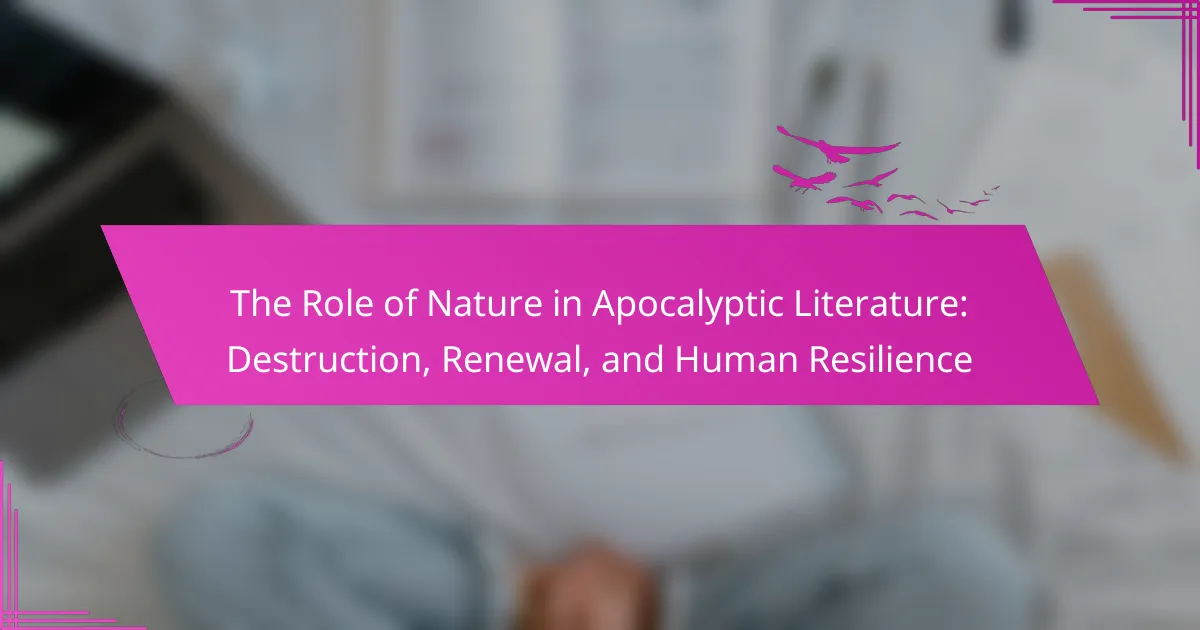Nature plays a pivotal role in apocalyptic literature, symbolizing both destruction and renewal. Catastrophic events highlight humanity’s vulnerability, while the imagery of recovery reflects resilience. Cultural perspectives shape these narratives, influencing interpretations of nature’s duality. Ultimately, these stories emphasize the interconnectedness of destruction and renewal, urging a reexamination of our relationship with the environment.
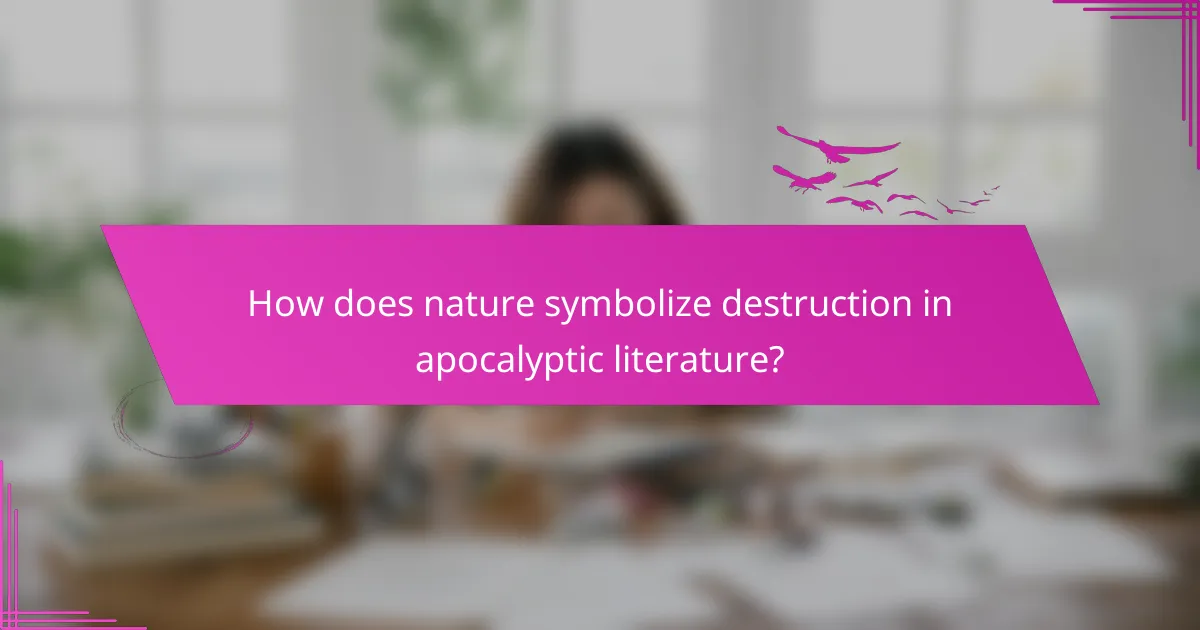
How does nature symbolize destruction in apocalyptic literature?
Nature symbolizes destruction in apocalyptic literature through catastrophic events like floods, wildfires, and earthquakes. These elements reflect humanity’s vulnerability and the chaos of impending doom. Such depictions often serve as metaphors for moral decay and societal collapse. Additionally, nature’s destructive power prompts themes of renewal and resilience, illustrating the cyclical nature of existence. For instance, in works like “The Road” by Cormac McCarthy, desolate landscapes signify both loss and the potential for rebirth.
What are the common natural disasters depicted?
Common natural disasters depicted in apocalyptic literature include earthquakes, floods, wildfires, hurricanes, and volcanic eruptions. These events symbolize destruction and the fragility of human existence. Each disaster highlights themes of renewal and resilience, showcasing humanity’s struggle to adapt and survive. For instance, floods often represent cleansing and rebirth, while wildfires illustrate both devastation and the potential for regeneration.
How do environmental changes reflect societal collapse?
Environmental changes often signify societal collapse by exposing vulnerabilities in human systems. Natural disasters, climate shifts, and resource depletion reveal the fragility of societal structures. These changes can lead to widespread panic, migration, and conflict, undermining social cohesion.
In apocalyptic literature, nature’s role reflects destruction and renewal, illustrating human resilience amid chaos. For instance, the aftermath of environmental collapse often serves as a backdrop for exploring themes of survival and adaptation. This literary trend emphasizes how societies can emerge stronger from adversity, highlighting a unique attribute of human tenacity.
Moreover, the portrayal of nature in these narratives can serve as a rare attribute, showcasing its dual capacity for both devastation and regeneration. This duality reinforces the idea that environmental changes are not merely destructive but also opportunities for renewal, echoing real-world ecological cycles.
Ultimately, the intersection of environmental change and societal collapse in literature mirrors ongoing global challenges, prompting reflection on humanity’s relationship with nature and the resilience required to adapt and thrive.

In what ways does nature serve as a catalyst for renewal?
Nature acts as a catalyst for renewal by providing healing, regeneration, and inspiration. In apocalyptic literature, landscapes often depict both destruction and the potential for rebirth. The imagery of nature recovering from devastation symbolizes hope and resilience. For instance, after catastrophic events, flora and fauna often reestablish themselves, illustrating the cycle of life. This renewal reflects human resilience, emphasizing that even in dire circumstances, there remains a path to recovery and growth.
Which natural elements signify hope and rebirth?
Natural elements that signify hope and rebirth include flowers, trees, and water. Flowers symbolize new beginnings, as they bloom after winter. Trees represent strength and endurance, often regrowing after destruction. Water signifies renewal, sustaining life and fostering growth. These elements reflect resilience in apocalyptic literature, embodying the cycle of destruction and renewal.
How do ecosystems recover in post-apocalyptic narratives?
Ecosystems in post-apocalyptic narratives often recover through natural resilience and human intervention. Nature reclaims spaces, demonstrating the root attribute of regeneration. Unique attributes include the emergence of new species adapted to altered environments. Rare attributes may involve symbiotic relationships that form in the absence of human influence. These themes highlight the interplay of destruction and renewal, emphasizing human resilience in adapting to new ecological realities.
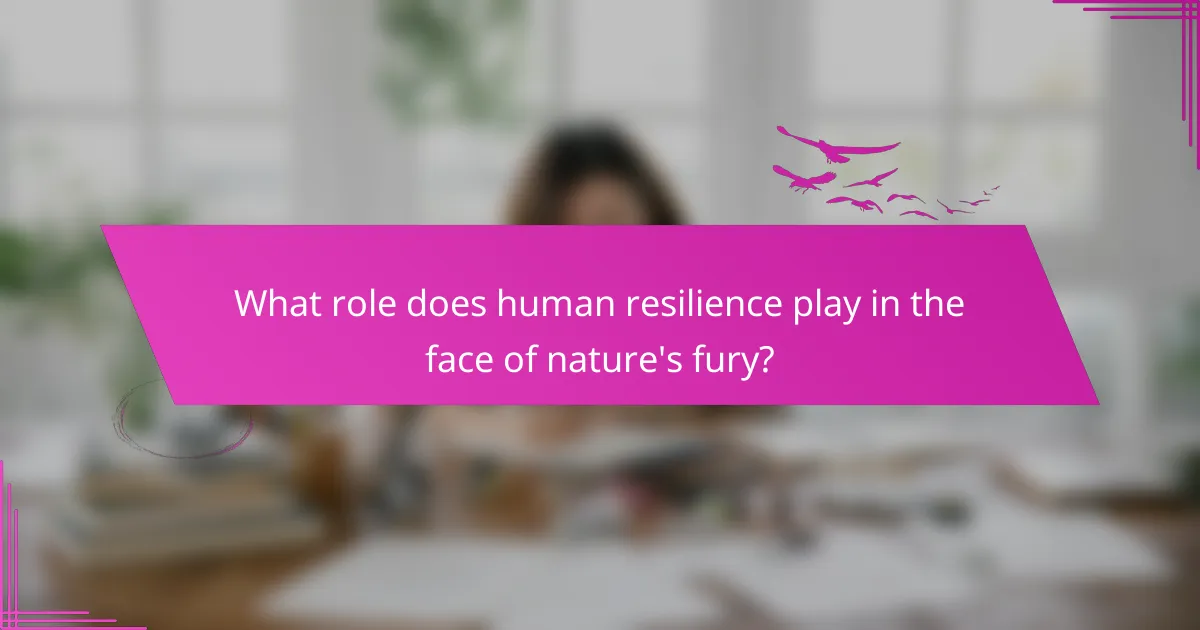
What role does human resilience play in the face of nature’s fury?
Human resilience is crucial in overcoming nature’s fury, enabling recovery and adaptation. In apocalyptic literature, this theme highlights humanity’s strength amidst destruction. Resilience manifests through community support, innovation, and a renewed appreciation for the environment. These narratives often illustrate how individuals and societies rebuild, fostering hope and growth after catastrophic events. The unique attribute of resilience lies in its ability to transform despair into determination, showcasing the indomitable human spirit.
How do characters adapt to changing environments?
Characters in apocalyptic literature often adapt to changing environments by demonstrating resilience and resourcefulness. They navigate destruction and chaos, showcasing human tenacity in the face of adversity. For example, characters may develop new survival skills or form alliances, reflecting the unique attribute of adaptability. This transformation often leads to personal growth, as they find renewed purpose amid devastation. Such narratives highlight the interplay between nature and humanity, emphasizing that renewal can arise from destruction, reinforcing the core theme of resilience.
What lessons can be learned from humanity’s relationship with nature?
Humanity’s relationship with nature teaches resilience and the importance of environmental stewardship. Apocalyptic literature often depicts nature’s dual role in destruction and renewal, reflecting human vulnerability and adaptability. Through these narratives, readers learn that environmental neglect leads to dire consequences, while reverence for nature fosters recovery and hope. This dynamic emphasizes the need for sustainable practices to prevent future crises and highlights the enduring strength of the human spirit in the face of adversity.
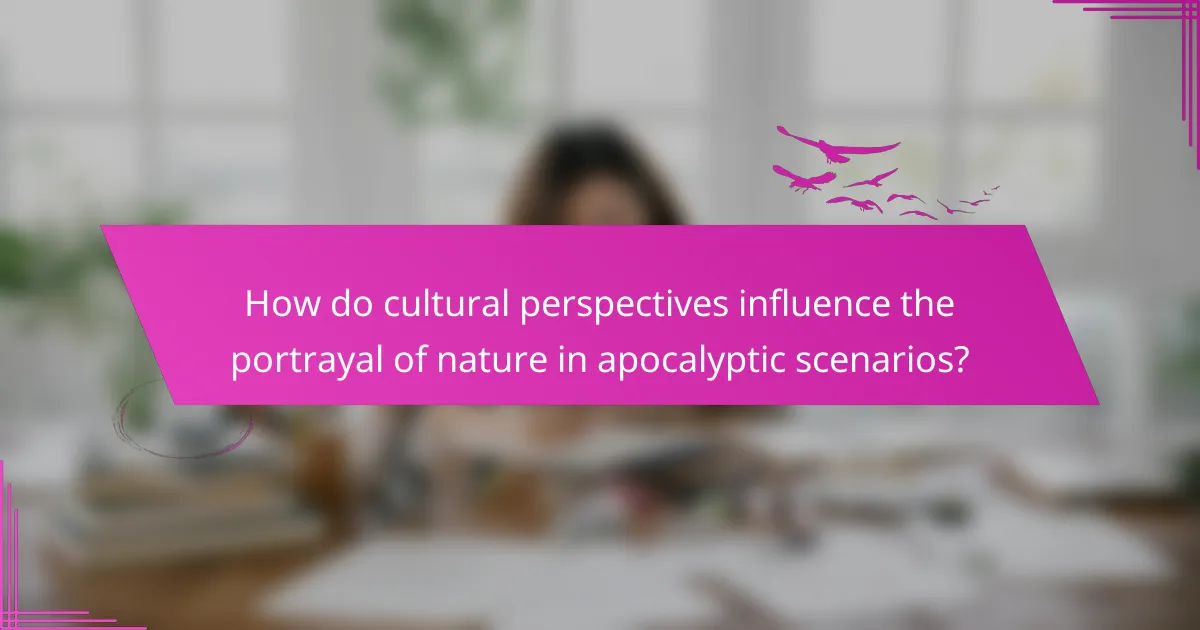
How do cultural perspectives influence the portrayal of nature in apocalyptic scenarios?
Cultural perspectives significantly shape the portrayal of nature in apocalyptic literature. Different cultures interpret natural elements uniquely, influencing themes of destruction and renewal.
For instance, Western narratives often emphasize nature’s wrath, presenting apocalyptic events as punishment for human excess. In contrast, Indigenous perspectives may depict nature as a resilient force, highlighting the potential for rebirth and harmony post-catastrophe.
These varying portrayals reflect deeper cultural values, such as respect for the environment or the belief in humanity’s dominance over nature. Ultimately, these perspectives foster human resilience, showcasing diverse responses to existential threats.
Which regional myths shape our understanding of nature’s role?
Regional myths significantly influence our understanding of nature’s role in apocalyptic literature. They often depict nature as a powerful force that can bring destruction or renewal. For example, in many cultures, floods symbolize both devastation and the potential for rebirth. These narratives highlight human resilience in the face of natural calamities, showcasing the interplay between humanity and the environment. Myths serve as a lens through which we interpret the consequences of ecological imbalance and the hope for restoration, reinforcing the idea that nature’s cycles are integral to human existence.
How do different cultures interpret destruction and renewal?
Different cultures interpret destruction and renewal as interconnected cycles reflecting human resilience. Many view natural disasters as a form of cleansing, leading to rebirth and regeneration. For instance, in Hinduism, destruction by Shiva is seen as a necessary precursor to creation. Similarly, indigenous cultures often embrace the idea that nature’s upheavals can restore balance and harmony. This perspective fosters a sense of hope and renewal amidst chaos. In contrast, some Western narratives focus on apocalyptic themes, emphasizing the end of civilization but often hinting at potential regeneration. Overall, these interpretations highlight the complex relationship between destruction, renewal, and the enduring human spirit.
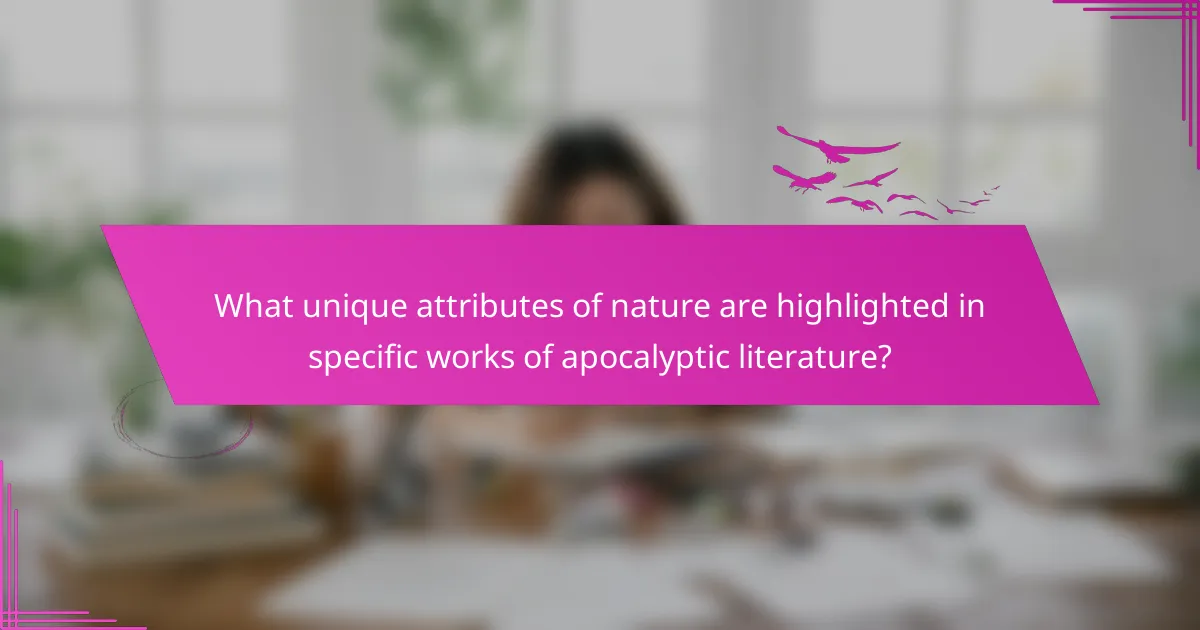
What unique attributes of nature are highlighted in specific works of apocalyptic literature?
Apocalyptic literature uniquely highlights nature’s dual role in destruction and renewal. Works like “The Road” by Cormac McCarthy emphasize barren landscapes symbolizing despair. In contrast, “The Overstory” by Richard Powers showcases nature’s resilience, illustrating interconnectedness and hope. These contrasting depictions reveal humanity’s relationship with the environment during crises.
Which authors provide distinctive views on nature’s role?
Authors like Cormac McCarthy, Margaret Atwood, and Octavia Butler offer distinctive views on nature’s role in apocalyptic literature. They explore themes of destruction, renewal, and human resilience through various narrative techniques.
Cormac McCarthy’s “The Road” portrays a bleak landscape where nature’s devastation reflects human despair. In contrast, Margaret Atwood’s “Oryx and Crake” examines the consequences of genetic manipulation on the environment, emphasizing the need for ecological balance. Octavia Butler’s “Parable of the Sower” highlights nature’s resilience and the potential for rebirth amidst societal collapse.
These authors uniquely illustrate how nature serves as both a backdrop and a character, influencing human actions and survival in apocalyptic scenarios. Their works encourage readers to reflect on humanity’s relationship with the natural world and the consequences of neglecting this bond.
How do literary devices enhance the depiction of nature?
Literary devices enhance the depiction of nature by illustrating its dual role in destruction and renewal. Metaphors and similes vividly convey the chaotic beauty of apocalyptic landscapes, while personification evokes emotional responses to nature’s fury. Imagery immerses readers in the sensory experience of a devastated environment, highlighting human resilience amidst adversity. Symbolism often connects nature to themes of rebirth, reinforcing the cyclical patterns of life and death. These devices create a rich tapestry that deepens the narrative and emphasizes the complex relationship between humanity and the natural world.
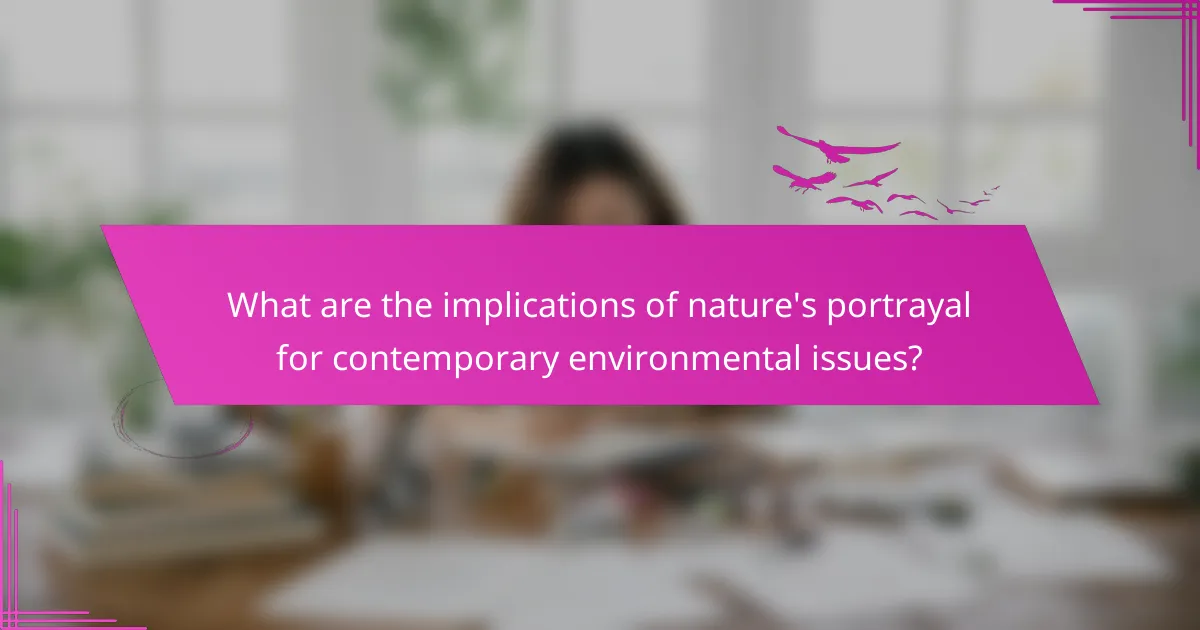
What are the implications of nature’s portrayal for contemporary environmental issues?
Nature’s portrayal in apocalyptic literature highlights the interconnectedness of destruction and renewal, influencing contemporary environmental issues. This literature often reflects human resilience against ecological disasters, emphasizing the need for sustainable practices. As a result, these narratives inspire collective action to address climate change and biodiversity loss. The unique attribute of nature’s duality serves as a powerful metaphor for current environmental challenges, urging society to rethink its relationship with the natural world.
How can lessons from literature inform real-world ecological challenges?
Literature often illustrates how nature responds to human actions, offering insights into ecological challenges. Apocalyptic literature emphasizes destruction caused by environmental neglect, highlighting the consequences of human resilience and the potential for renewal. For example, in works like “The Road” by Cormac McCarthy, the desolate landscape mirrors societal collapse, prompting reflection on sustainable practices. These narratives can inspire real-world solutions by showcasing the importance of ecological balance and the need for stewardship. Ultimately, they remind us that renewal is possible through conscious efforts to restore and protect our environment.
What are the best practices for integrating environmental themes in storytelling?
Integrating environmental themes in storytelling enhances depth and relevance. Focus on depicting nature’s dual role in destruction and renewal, showcasing human resilience. Use vivid imagery to illustrate landscapes before and after apocalyptic events, emphasizing the contrast. Incorporate ecological principles to ground narratives, reflecting real-world environmental issues. Characters can embody various responses to ecological crises, from despair to hope, illustrating diverse human experiences. This approach fosters a connection between readers and the environment, encouraging reflection on sustainability.
